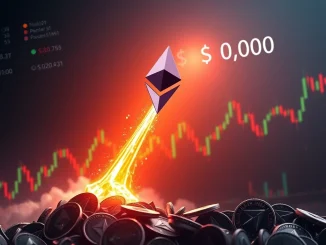
The world of finance is constantly evolving, and a key player in this transformation is the concept of tokenization. Recently, U.S. SEC Commissioner Hester Peirce, often dubbed ‘Crypto Mom’ for her balanced views on digital assets, pointed to tokenization as a potentially transformative force for the structure and operation of financial markets. This isn’t just a buzzword; it’s a shift that could redefine how assets are owned, traded, and managed globally.
What is Tokenization and Why Does the SEC Care?
At its core, tokenization involves representing ownership rights or value of an asset (like real estate, art, stocks, or even commodities) on a blockchain network as a digital token. Think of it like creating a digital certificate of ownership that’s easily verifiable, divisible, and transferable. The SEC, as the primary regulator of securities markets in the U.S., pays close attention to anything that could fundamentally alter these markets.
Commissioner Peirce’s remarks, as reported by Watcher Guru, underscore a growing recognition within regulatory bodies of the potential impact of this technology. It suggests that regulators are actively considering how tokenization fits within existing frameworks and how it might necessitate new approaches.
How Can Tokenization Reshape Financial Markets?
The potential benefits highlighted by proponents of tokenization are significant and could lead to a major evolution in financial markets:
- Increased Efficiency: Automating processes like settlement and clearing using smart contracts on a blockchain can drastically reduce time and costs compared to traditional systems.
- Improved Liquidity: By fractionalizing high-value assets (like a building or a piece of art) into smaller, more affordable tokens, tokenization can open up investment opportunities to a wider range of investors, potentially increasing market depth and liquidity.
- Greater Accessibility: Lower barriers to entry for both investors and asset issuers can democratize access to capital markets.
- Enhanced Transparency: Transactions recorded on a public or permissioned blockchain provide a clear, immutable audit trail.
- Reduced Counterparty Risk: The use of smart contracts can enforce agreements automatically, reducing reliance on intermediaries.
This shift towards a tokenized future isn’t just theoretical; pilot programs and initiatives are already exploring its viability across various asset classes.
Challenges and Considerations for Tokenization and the SEC
While the potential is vast, the path to widespread tokenization in financial markets isn’t without hurdles. Regulatory clarity is paramount. The SEC, like other global regulators, faces the complex task of determining how existing securities laws apply to tokenized assets. Key questions include:
- When does a token constitute a security?
- How should tokenized platforms comply with regulations designed for traditional exchanges or broker-dealers?
- Ensuring investor protection in a novel digital environment.
- Addressing issues like custody, cybersecurity, and interoperability between different blockchain networks.
Commissioner Peirce has often advocated for regulatory frameworks that are adaptable and foster innovation rather than stifling it. Her emphasis on tokenization signals a need for ongoing dialogue between innovators and regulators to navigate these complexities effectively.
The Role of Blockchain in the Future of Finance
Tokenization is intrinsically linked to blockchain technology. Blockchain provides the secure, distributed ledger infrastructure necessary to issue, manage, and transfer these digital tokens reliably. The immutability and transparency offered by blockchain are foundational to the integrity of tokenized assets and markets.
As Commissioner Peirce suggests, the integration of blockchain and tokenization could lead to a more resilient, efficient, and accessible financial system. This evolution won’t happen overnight, but the acknowledgment from a key regulator like the SEC indicates that tokenization is firmly on the radar and poised to play a significant role in the future landscape of finance.
Looking Ahead: Actionable Insights
For participants in both the traditional financial sector and the crypto space, Commissioner Peirce’s comments offer valuable insights:
- Stay Informed: Keep track of regulatory discussions and proposals surrounding tokenization.
- Explore Pilot Programs: Consider how tokenization could be applied to specific assets or processes within your organization.
- Engage with Regulators: Participate in public consultations and provide feedback on potential frameworks.
- Focus on Compliance: Build solutions with compliance considerations from the outset.
The convergence of traditional finance and blockchain technology through tokenization is a trend with profound implications. Understanding its potential and the regulatory landscape is crucial for anyone looking to navigate the future of financial markets.
Conclusion
SEC Commissioner Hester Peirce’s recognition of tokenization as a key driver for the evolution of financial markets highlights a significant point of convergence between traditional finance and the digital asset world. While challenges remain, the potential for increased efficiency, liquidity, and accessibility is undeniable. As regulators continue to study and engage with this technology, the path towards a more tokenized financial future becomes clearer, promising exciting developments for investors and institutions alike.



